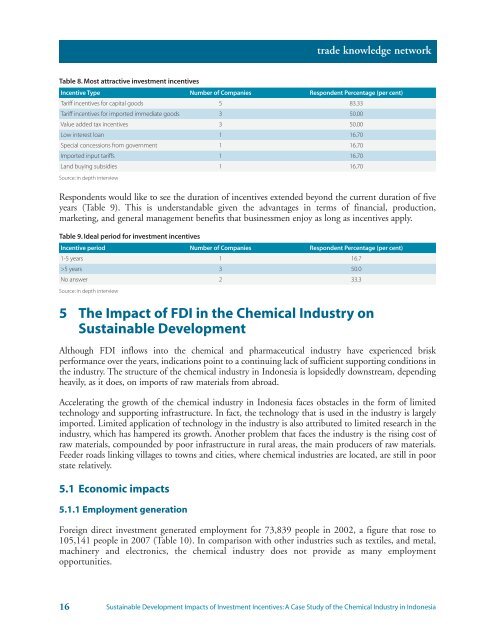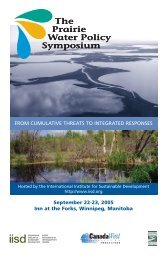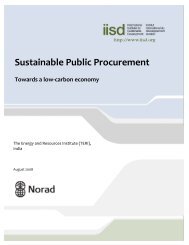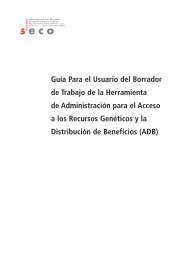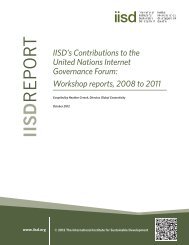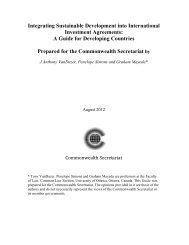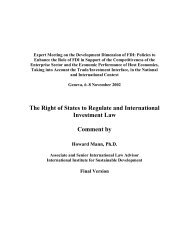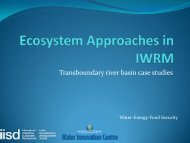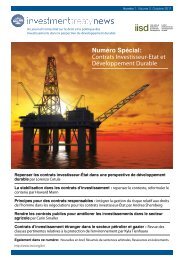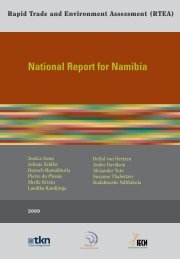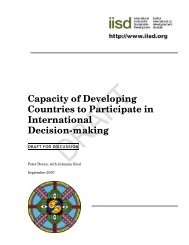Sustainable Development Impacts of Investment Incentives: A Case ...
Sustainable Development Impacts of Investment Incentives: A Case ...
Sustainable Development Impacts of Investment Incentives: A Case ...
You also want an ePaper? Increase the reach of your titles
YUMPU automatically turns print PDFs into web optimized ePapers that Google loves.
trade knowledge network<br />
Table 8. Most attractive investment incentives<br />
Incentive Type Number <strong>of</strong> Companies Respondent Percentage (per cent)<br />
Tariff incentives for capital goods 5 83.33<br />
Tariff incentives for imported immediate goods 3 50.00<br />
Value added tax incentives 3 50.00<br />
Low interest loan 1 16.70<br />
Special concessions from government 1 16.70<br />
Imported input tariffs 1 16.70<br />
Land buying subsidies 1 16.70<br />
Source: in depth interview<br />
Respondents would like to see the duration <strong>of</strong> incentives extended beyond the current duration <strong>of</strong> five<br />
years (Table 9). This is understandable given the advantages in terms <strong>of</strong> financial, production,<br />
marketing, and general management benefits that businessmen enjoy as long as incentives apply.<br />
Table 9. Ideal period for investment incentives<br />
Incentive period Number <strong>of</strong> Companies Respondent Percentage (per cent)<br />
1-5 years 1 16.7<br />
>5 years 3 50.0<br />
No answer 2 33.3<br />
Source: in depth interview<br />
5 The Impact <strong>of</strong> FDI in the Chemical Industry on<br />
<strong>Sustainable</strong> <strong>Development</strong><br />
Although FDI inflows into the chemical and pharmaceutical industry have experienced brisk<br />
performance over the years, indications point to a continuing lack <strong>of</strong> sufficient supporting conditions in<br />
the industry. The structure <strong>of</strong> the chemical industry in Indonesia is lopsidedly downstream, depending<br />
heavily, as it does, on imports <strong>of</strong> raw materials from abroad.<br />
Accelerating the growth <strong>of</strong> the chemical industry in Indonesia faces obstacles in the form <strong>of</strong> limited<br />
technology and supporting infrastructure. In fact, the technology that is used in the industry is largely<br />
imported. Limited application <strong>of</strong> technology in the industry is also attributed to limited research in the<br />
industry, which has hampered its growth. Another problem that faces the industry is the rising cost <strong>of</strong><br />
raw materials, compounded by poor infrastructure in rural areas, the main producers <strong>of</strong> raw materials.<br />
Feeder roads linking villages to towns and cities, where chemical industries are located, are still in poor<br />
state relatively.<br />
5.1 Economic impacts<br />
5.1.1 Employment generation<br />
Foreign direct investment generated employment for 73,839 people in 2002, a figure that rose to<br />
105,141 people in 2007 (Table 10). In comparison with other industries such as textiles, and metal,<br />
machinery and electronics, the chemical industry does not provide as many employment<br />
opportunities.<br />
16<br />
<strong>Sustainable</strong> <strong>Development</strong> <strong>Impacts</strong> <strong>of</strong> <strong>Investment</strong> <strong>Incentives</strong>: A <strong>Case</strong> Study <strong>of</strong> the Chemical Industry in Indonesia


